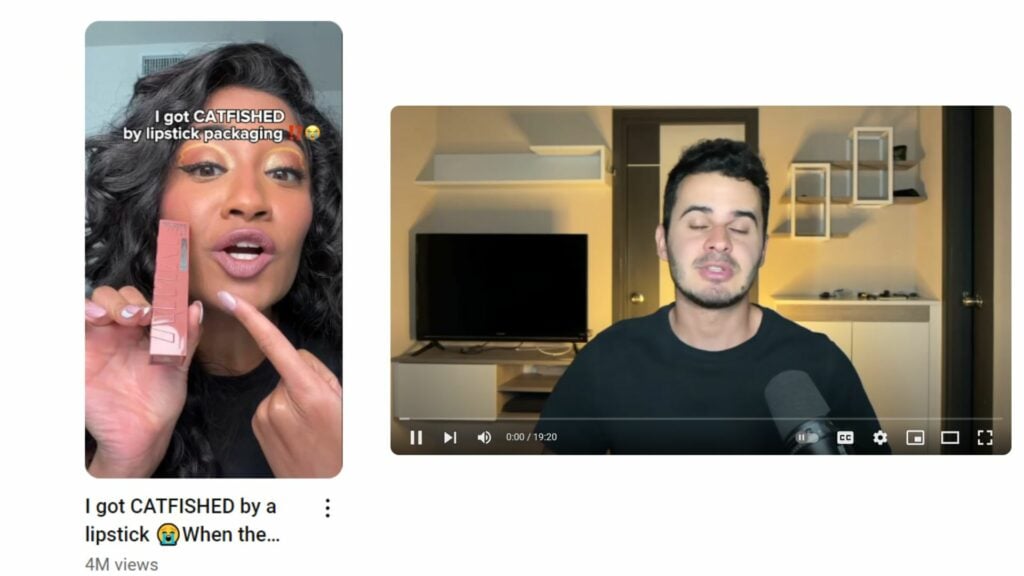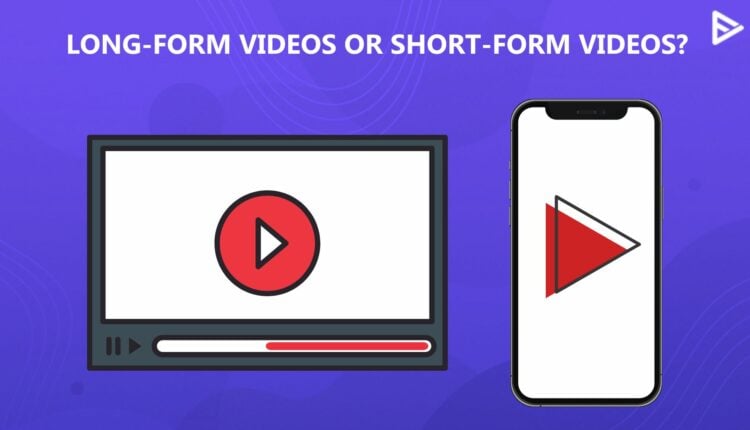YouTube Shorts may have arrived late, but they’ve quickly overtaken the platform. Creators everywhere are flocking to short-form videos, leaving many wondering: Is there still room for long-form content? Despite the buzz around Shorts, both formats have unique strengths that can fuel your channel’s growth. Today, we will discuss the most awaited debate, YouTube shorts vs videos, which is better for deciding what works best for your channel.
Which Video Format Is Best: YouTube Shorts And Videos?

It is natural to get confused about which video format to choose for promotions. Here’s the in-depth difference between long-form vs. short-form content to understand what’s required the most.
YouTube Shorts
YouTube shorts are short-form content created to quickly capture viewers’ attention on your channel and grow your subscriber base.
Nowadays, nobody likes to watch long videos. YouTube shorts are short-form videos that encourage viewers to watch them to the end, increasing engagement.
These video formats are used for quick messaging, which allows creators to communicate with viewers and deliver the message within 60 seconds. However, now you can also upload YouTube shorts up to 3 minutes long, according to the recent update.
So, if you are a business owner, YouTube shorts are a great way to attract an audience and increase brand awareness.
According to the statistics, YouTube shorts see a 60-70% increase in user engagement.
YouTube Shorts’ production timing is generally shorter than that of YouTube videos, which can be created in a few minutes with good, trendy music.
YouTube Videos
Where YouTube shorts have restrictions over the duration, videos have a free hand.
YouTube videos are long-form videos that allow you, as the creator, to provide in-depth information about a brand or a topic.
The length of the videos can range from a few seconds to hours.
As a business, long-form content lets you conduct in-depth storytelling to hook viewers and engage them on a deep emotional level.
Such videos are usually for viewers who are willing to invest their time and attention and watch them to the end.
It also helps build a stronger connection with the audience, addressing their pain points.
Creators focusing on long-form videos rather than short forms often have higher retention rates and ad revenue.
According to VidIQ, creators who effectively combine Shorts with long-form content witness a 45% increase in viewer retention rates.
How Do YouTube Shorts Differ From Regular Videos?
YouTube Shorts and regular videos both have distinct features and benefits. Let’s look at both Shorts or Video, which is better using different categories:
Discoverability
YouTube shorts appear like a for-you page for Instagram reels and TikTok. With YouTube shorts, your chances of increasing your channel’s visibility double. YouTube videos are in the regular feed or on the recommendation pages. You generate the impression but not the clicks until the viewer clicks on them.
Infusing keywords in your video title and description is a great way of increasing your video’s discoverability. So you can get crisp and compelling titles from AI YouTube Title Generator, while for engaging video descriptions you can also use AI YouTube Description Generator! Both tools offer creators around 30 tones to pick and choose from.
Audience Engagement
YouTube shorts are shorter in duration, so they captivate the audience quickly. The best way to fully leverage YouTube shorts is by walking through the trends and challenges.
As watching long-form videos requires too much time, viewers tend to leave the video in between. However, if you have focused on the hookups, titles, and descriptions, it may let them not just click but watch the entire video. Audience Retention also relies heavily on your information and how relevant your content is for the audience.
Monetization
Monetizing a YouTube channel is the ultimate goal of every creator. Many things that one is supposed to use to make money on YouTube. Now, if we talk about YouTube shorts, they are under the YouTube partner program, allowing creators to monetize through ads, channel memberships, and super chat. YouTube videos also fall under YPP but can help you make money through ad revenue and sponsorships.
Production Time
Production time is the one thing that matters a lot when deciding which content format to choose. YouTube shorts are quick video content that can be created faster than regular videos, which take a few days. Selecting the format again depends on your requirements. If you want to create short & quick promotion content, YouTube shorts are the top content type. However, if you are making a review video, the long video would be best as it also builds the relationship with viewers.
Things To Consider
Here are some facts that will force you to think harder – whether it’s YouTube Shorts or YouTube Videos?
More than 70% of YouTube viewers prefer scrolling through YouTube shorts to watching videos during leisure time. On the other hand, long-form content allows you to generate more revenue owing to multiple ad placements within the video.
But as a creator, you will witness exponential growth if you can leverage both content formats efficiently!
When Is The Ideal Time To Upload YouTube Shorts?
The best time to upload YouTube shorts is during peak hours, from 11 am to 3 pm and from 7 pm to 10 pm. This is ours, and you have to follow it on weekdays. For weekends, schedule your video around 8 pm to 11 pm. Remember that uploading time is decided based on different factors, and the creator’s location is one of them. One thing you can do is understand the peak time of your region when viewers are likely to have leisure time and be active on YouTube. Then, upload your content.
The Power of Combining YouTube Shorts and Long Videos
Instead of choosing one, I suggest you use both. They both have advantages based on your needs and strategies. Crayola, one of the famous color brands, has been using only long videos for promotion. However, when they tried shorts for brand awareness, it helped them boost their subscriber count and achieved 400k subscribers in a year. The brand says one should leverage both content formats and never settle down to one, as any of them can help reach their desired goals. Using both content formats, in fact, is Crayola’s one of the YouTube content strategies that everyone should follow.
Shorts vs Video YouTube Monetization Overview
YouTube Videos: Regular YouTube videos tend to generate more revenue. They have more ad placement opportunities. The cost per mille (CPM) rate can be used to calculate the earnings. Some YouTube niches generate more revenue because advertisers are willing to pay higher rates. Using CPM, you can determine your earnings for the current bid and calculate future bids as well.
YouTube Shorts: The payout for Shorts is limited. However, the Shorts are best used for brand collaborations. This increases the earnings exponentially. You can download your media kit to showcase the brands and advertisers that your Shorts have potential thus unlocking a significant monetization opportunity.
Conclusion
YouTube Shorts and long-form videos serve distinct purposes, so choosing just one wouldn’t be fair to your channel’s potential. It’s crucial to understand your channel’s needs and goals before deciding which format to focus on.
Breaking it down: YouTube Shorts are perfect for building brand awareness and boosting engagement and your subscriber base. However, if your primary goal is earning revenue, long-form videos are the better choice.
Whether you choose short-form or long-form content, the most important thing is to create content that your viewers love so they keep coming back for more. Learning how to promote video on YouTube can also help you gain quick visibility and growth.
Frequently Asked Questions
Q1. Which is more profitable, YouTube Shorts or videos?
According to the reports, YouTube shorts have less RPM pr revenue per 1000 views compared to long-form videos. You may earn around 1¢ and 7¢ RPM, but when it comes to long-form videos, you earn, on average, around $1 to $20 RPM.
Q2. What pays more, YouTube Shorts or videos?
YouTube videos pay more than YouTube shorts. Even when you look at the revenue, YouTube videos get RPM between $1 to $30 per 100 views, and the average RPM for YouTueb shorts is 1¢ and 6¢.
Q3. Do Shorts get more views than videos?
YouTube shorts are likely to receive more views than regular videos as they are massively promoted by the YouTube algorithm.
Q4. Can you convert a YouTube short to a video?
Yes. You can convert a YouTube short to a video using a third-party tool or by reuploading the downloaded YouTube short as a regular video. YouTube now also offers a create-a-video highlight feature to shorten your long videos and promote them on the platform.
Summary
- YouTube Shorts have rapidly gained popularity, prompting creators to question the viability of long-form content.
- Short-form content like YouTube Shorts increases viewer engagement and is designed for quick messaging, while long-form videos allow for in-depth storytelling.
- Both formats offer unique monetization opportunities, but long-form videos generally provide higher revenue due to more ad placements.
- Combining both YouTube Shorts and long-form videos can maximize channel growth and audience engagement, as demonstrated by successful brands like Crayola.


